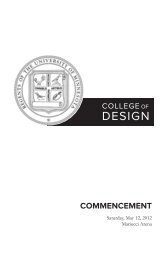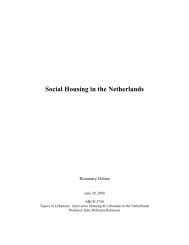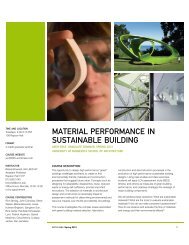THE NEW ARCHITECTURE OF THE SUN AND WIND: - School of ...
THE NEW ARCHITECTURE OF THE SUN AND WIND: - School of ...
THE NEW ARCHITECTURE OF THE SUN AND WIND: - School of ...
Create successful ePaper yourself
Turn your PDF publications into a flip-book with our unique Google optimized e-Paper software.
PRIORITIZE PASSIVE <strong>AND</strong> RE<strong>NEW</strong>ABLE<br />
DESIGN: STRIVE FOR ENERGY<br />
PRODUCTION<br />
Steinhude Sea Recreation Facility, Randall Stout<br />
Architects et al., and the City <strong>of</strong> Steinhude<br />
Can designers go beyond net-zero energy targets to<br />
create an architecture that actually produces rather than<br />
consumes energy? Can architecture help meet the<br />
energy needs <strong>of</strong> the building, the community, and the<br />
world beyond? To achieve environmentally benign<br />
energy production, designers need to optimize passive<br />
strategies and harvest free site energy for lighting,<br />
ventilation, and heating, while also integrating renewable<br />
energy systems. The Steinhude Sea Recreation Facility,<br />
located on a small island in Germany, meets ambitious<br />
energy goals while also supporting the site’s ecology<br />
and enriching the user’s experience. The compound<br />
includes a lifeguard station, boathouse, storage facility,<br />
and public building with a café, restrooms and showers,<br />
exhibitions, and an observation area.<br />
Designed by Randall Stout Architects, a team <strong>of</strong> German<br />
architects and engineers, and the city <strong>of</strong> Steinhude, the<br />
facility is energy self-reliant, with 100 percent <strong>of</strong> its<br />
needs met on-site through passive and active solar<br />
systems and other renewable energy technologies.<br />
Passive systems are used for natural ventilation and<br />
daylighting, while active systems provide domestic hot<br />
water, space heating, and electricity via solar hot water<br />
collectors, photovoltaic panels, a ground-source<br />
geothermal heat pump, and a seed oil–fueled<br />
cogeneration microturbine. The microturbine is used for<br />
backup power on overcast days. An annual 60,000<br />
kilowatt hours <strong>of</strong> energy is produced, with an equivalent<br />
60,000-kilogram yearly reduction in carbon dioxide<br />
emissions. Surplus energy is used to run a fleet <strong>of</strong> solarpowered<br />
boats, and the remainder is sold back to the<br />
utility grid. Reducing initial loads and overall energy<br />
consumption through programming, design, and efficient<br />
systems were fundamental to the project’s success.<br />
During the coming decades architecture will have to<br />
adopt new methods <strong>of</strong> energy production at the site,<br />
local, and regional scale. Steinhude provides an<br />
Steinhude exterior view<br />
Photo by Peter Hübbe<br />
-5-







